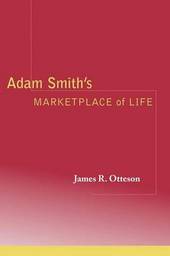
|
Adam Smith's Marketplace of Life
Paperback / softback
Main Details
| Title |
Adam Smith's Marketplace of Life
|
| Authors and Contributors |
By (author) James R. Otteson
|
| Physical Properties |
| Format:Paperback / softback | | Pages:354 | | Dimensions(mm): Height 228,Width 152 |
|
| Category/Genre | Ethics and moral philosophy
Social and political philosophy |
|---|
| ISBN/Barcode |
9780521016568
|
| Classifications | Dewey:170.92 |
|---|
| Audience | | Professional & Vocational | |
|---|
| Illustrations |
Worked examples or Exercises
|
|
Publishing Details |
| Publisher |
Cambridge University Press
|
| Imprint |
Cambridge University Press
|
| Publication Date |
10 October 2002 |
| Publication Country |
United Kingdom
|
Description
Adam Smith wrote two books, one about economics and the other about morality. His Wealth of Nations argues for a largely free-market economy, while his Theory of Moral Sentiments argues that human morality develops out of a mutual sympathy that people seek with one another. How do these books go together? How do markets and morality mix? James Otteson provides a comprehensive examination and interpretation of Smith's moral theory and shows how his conception of the nature of morality applies to his understanding of markets, language and other social institutions. Considering Smith's notions of natural sympathy, the impartial spectator, human nature, and human conscience the author also addresses the issue of whether Smith thinks that moral judgments enjoy a transcendent sanction. James Otteson sees Smith's theory of morality as an institution that develops unintentionally but nevertheless in an orderly way according to a market model.
Reviews'... a substantial and important study of Adam Smith's moral theory ... ambitious in its scope and coverage ...'. David Lieberman, School of Law, University of California, Berkeley '... rigorously argued, using just the right amount of references and citations, and written in a clear and concise language; the author drives his point home with remarkable effectiveness ...'. Canadian Journal of Political Science '... this is an important study with a distinctive contribution to debates about the 'Adam Smith problem'; it provides some stimulating arguments that deserve considered attention and will no doubt prompt further debate.' British Journal for the History of Philosophy
|